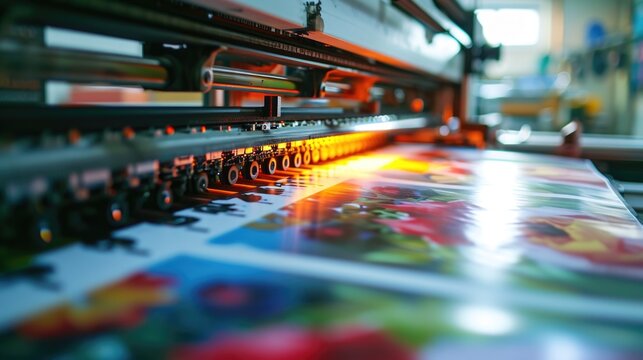In the world of printing, there has been a delighted embrace of flexography as a significant method for producing high-quality prints at a tremendous speed. Whether you’re a business professional looking to understand the intricacies of this technology or someone exploring the world of printing, learning how flexography works is both fascinating and enriching.
The primary keyword how flexography works serves as our guide as we delve into the mechanics and benefits of this innovative printing method.

The Basics of Flexography
Flexography, often referred to as ‘flexo,’ is a modern high-speed printing method that’s widely used for printing labels, packaging, and a variety of other products. It utilizes flexible plates, typically made of rubber or plastic, to transfer ink onto different materials like paper, plastic, and metallic films.
History and Evolution
Flexography has come a long way since its inception in the early 20th century. Initially called ‘aniline printing,’ it faced numerous challenges due to the toxic nature of aniline inks. However, with the advent of approved non-toxic inks, the process quickly gained traction and was later renamed flexography.
Discover the evolution of label printing for more details.
How Does Flexography Work?
The process of flexography is relatively simple yet efficient. It begins with the preparation of a flexible plate, which contains the image to be printed. This plate is inked and pressed against the substrate, transferring the image with remarkable clarity and precision. Employing a range of inks from water-based to UV-cured, flexography is versatile and adapts to diverse printing needs.
Components Involved
Several key components make up the flexographic printing process, including:
- Anilox Roll: Engraved with tiny cells that hold and transfer ink to the plate.
- Doctor Blade: Clears excess ink from the Anilox Roll, ensuring precision.
- Flexographic Plate: Flexible enough to wrap around a cylinder for inking.
- Substrate Material: The material on which the design is printed.
Advantages of Flexography
Flexography holds several advantages, making it a popular choice among printing professionals:
High-Speed Production
One of the standout features of flexographic printing is its speed. Capable of producing long runs with minimal downtime, it proves to be particularly beneficial for large-scale operations.
Versatility in Substrates
Flexography can efficiently print on an array of materials, from delicate films to sturdy corrugated cardboard. This adaptability to various materials ensures widespread applications across industries.
Cost-Effectiveness
With lower labor costs and reduced ink consumption, flexography emerges as a cost-effective solution, especially for businesses dealing with bulk orders.
Flexography in Modern Printing
Today, flexography continues to evolve with advancements in big printing technology. From digitization enabling more precise plate making to innovations in ink formulations boosting eco-friendliness, flexography remains at the forefront of modern printing solutions. Learn about printing business cards with flexography.
Flexography vs. Traditional Printing Methods
When compared to methods like lithography and gravure, flexography stands out for its swiftness and adjustability. While the initial setup might be pricey due to plate manufacturing, the increased speed and reduced wastage can offer long-term financial benefits.
Future of Flexography
With continuous advancements in digital printing and eco-conscious practices, flexography is poised to remain a vital asset to the printing industry. Expect more improvements in speed, precision, and sustainability, ensuring that flexography meets the demands of our rapidly changing world. Explore print-on-demand technology to understand its influence.
Applications of Flexographic Printing
Flexography isn’t just about labels and packaging. Its applications span across industries, offering vibrant and durable prints for everything from food packaging to wallpapers. This versatility greatly contributes to its popularity. Get insights into printing business cards that showcase its adaptability.
Environmental Impact
It’s not just about speed and versatility; flexography is also an environmentally friendly option. With the shift towards water-based inks and reduced waste production techniques, it aligns well with contemporary eco-friendly initiatives. Discover more about green label-making options.
Challenges and Considerations
Despite its merits, flexography does have some limitations. The upfront cost of plate creation and limitations with very fine detail can pose challenges. But with ongoing advancements, these obstacles are continuously being addressed.
Technological Developments
Innovation is constant in the world of flexographic printing. The integration of digital technology improves workflow efficiency and accuracy, paving the way for a new age of smart printing solutions.
Conclusion
Understanding how flexography works is crucial for anyone involved in the printing industry or businesses benefiting from economical and efficient printing methods. Its capacity to adapt, produce high volumes, and align with environmental standards ensures that flexography will remain a pivotal player in the field. As technology progresses, so will the applications and efficiency of flexographic printing.

FAQ Section
What materials can be used in flexography?
Flexographic printing can accommodate a wide range of substrates, including paper, plastics, metals, and films. This makes it highly versatile for different printing needs.
Is flexography environmentally friendly?
Yes, with the use of water-based and UV inks and new technologies minimizing waste, flexography is becoming more environment-friendly.
Why is flexography preferred for high-volume printing?
Due to its high speed, adaptability to various materials, and cost-effectiveness over long print runs, flexography is often the preferred choice for large-scale printing tasks.






